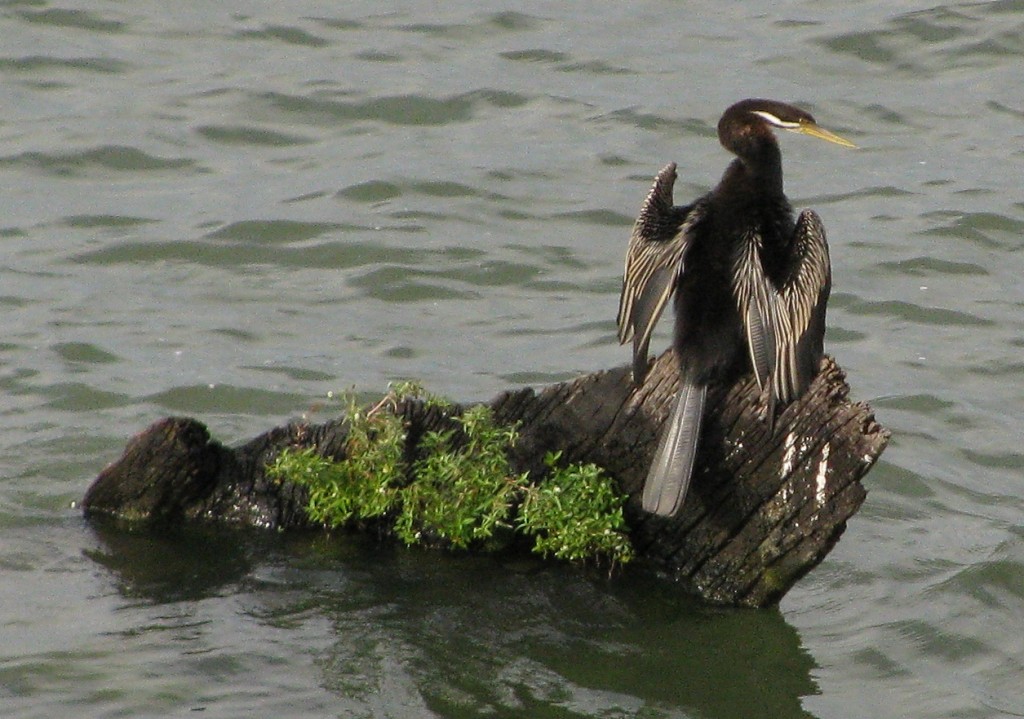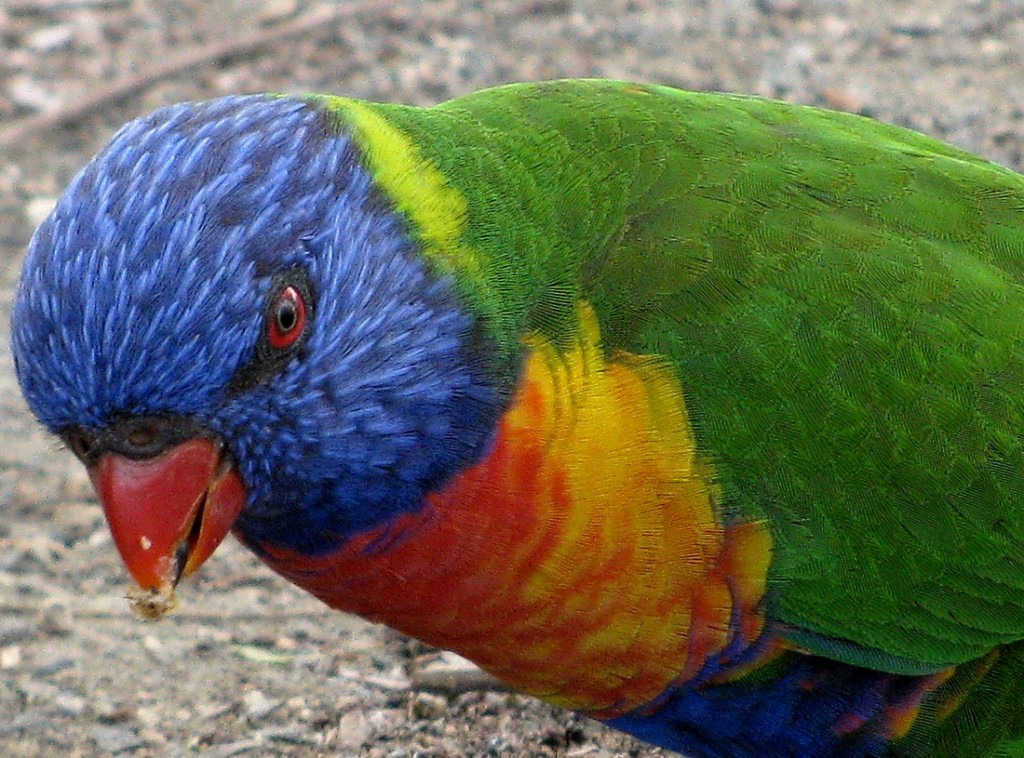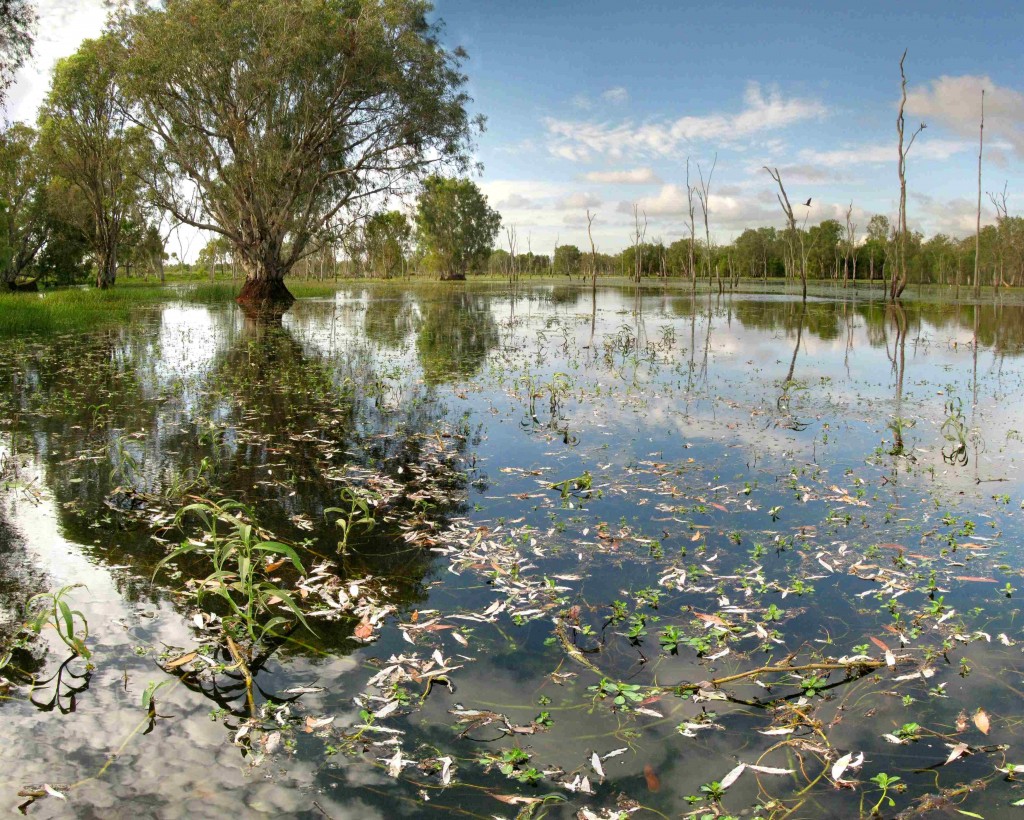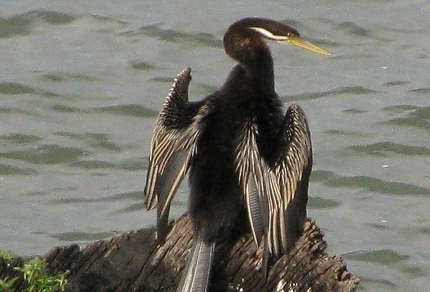
Male Anhinga, Ross River Dam, Townsville (© Magi Nams)
Before dawn’s first light, Vilis and I arose from our bed, breakfasted, and then, with the sun creeping above the horizon as a huge red ball, drove to Ross River Dam, where we joined the Townsville Region Bird Observers Club (TRBOC) for their monthly census of birdlife at the dam wetlands. The group had four visitors on this outing – a woman from Charters Towers and her guest from Melbourne, and two young American men studying at JCU in Townsville for a term. One of the young men jotted down each new species he observed with an obvious sense of satisfaction. “I list everything,” he told me. “My friends tell me that someday I’m going to be a twitcher.”
White-breasted woodswallows entertained us by crowding onto a post atop the dam, nudging and dislodging each other and eliciting laughter from the two young men. I pointed out the differences in bill shape between anhingas and little pied cormorants and identified the anhinga’s vocalization for the keen twitcher-to-be, who nodded and grinned in appreciation. In turn, an English woman gave me directions as to how to find two golden bowerbird maypole bowers in the vicinity of Birthday Creek, near Paluma, and her husband, also English, described a trail west of Paluma that’s good for sightings of satin bowerbirds, little lorikeets, and crested shrike-tits. Conversation was all about birds, one fellow sharing sightings, including a red-bellied pitta, from a recent trip to the Iron Ranges near the northern tip of Cape York Peninsula. We were united by one common thread – the lure of Aussie birds.
For many, birding is a pleasant or treasured hobby, while for others, it’s a life priority. Take Sean Dooley, author of The Big Twitch, who dedicated twelve months of his life and blew his inheritance to break the record for the number of Australian bird species seen in one year. In December of 2002, he topped out at 703 species, handily overtaking the old record of 633 species.1 This may seem an extreme example, but the fact that he had gone in pursuit of the record means that a significant number of other überbirders had set records before him. And it’s not only the Australians who are enthralled with their birds. Later this morning, while Vilis and I accompanied the English couple on a stroll around the Borrow Pits pond near Ross Dam, we learned that they’re living in Australia on retiree’s visas. When Vilis asked what had brought them to Australia, the woman said simply, “The birds.” It was an Englishman, Mike Entwhistle, who had set the record prior to Dooley’s.1
My 1997-edition bird guide includes 778 Australian bird species.2 The 2008 edition of BOCA’s Little Blue Birdlist (BOCA being the acronym for Bird Observation & Conservation Australia) lists 851 species that occur on the “Australian mainland and Tasmania, Lord Howe and Norfolk Islands, Ashmore Reef, Australian continental seas, Australian Antarctic Territory, Christmas, Cocos-Keeling, Heard, Macquarie and Torres Strail Islands.”3 This list includes not only birds native to Australia, but also those introduced to the continent and now surviving in the wild, as well as vagrant species native to other parts of the world that have shown up in Oz less than ten times.
Australia’s wonderful diversity of birds encompasses three of the world’s most primitive, flightless birds, the native emu and cassowary and introduced ostrich, as well as an impressive variety of advanced songbirds. Approximately 45% of Australia’s birds are endemic to this continent4 and, thus, are found nowhere else in the world. They include such Aussie icons as the emu and laughing kookaburra, as well as many members of the parrot order Psittaciformes and seven of Australia’s eight species of bowerbirds. It is this incredible diversity, along with the brilliant colours and intriguing lifestyles of many Australian birds, that act like the proverbial carrot dangling above this South Pacific continent, luring bird enthusiasts – myself included – from all over the world.

Rainbow Lorikeet (© Magi Nams)

Ross River Dam Wetland (© Vilis Nams)

Water Plants at Ross River Dam Wetland (© Vilis Nams)
Today’s birds: peaceful doves, mynas, Australian white ibises, magpie-larks, welcome swallows, masked lapwings, bush stone-curlew, sulphur-crested cockatoos, red-tailed black-cockatoos, common koel, brush cuckoo, olive-backed orioles, white-throated honeyeaters, pheasant coucal, yellow honeyeaters, great bowerbird, rainbow lorikeets, black kites, white-bellied sea eagles, Nankeen kestrel, anhingas, little black cormorants, black swans, little pied cormorants, intermediate egrets, blue-faced honeyeaters, Torresian crow, great egrets, royal spoonbills, white-breasted woodswallows, willie wagtail, white-bellied cuckoo-shrikes, forest kingfishers, cattle egret, blue-winged kookaburra, whistling kite, black-faced cuckoo-shrike, golden-headed cisticola, magpie geese, brown honeyeaters, little friarbirds, red-backed fairy wrens, little corella, Australian bustard, galahs, ospreys, Australian magpies, rainbow bee-eaters, house sparrows, figbirds, straw-necked ibis, nutmeg mannikins, sacred kingfisher, spangled drongo, rock doves, pale-headed rosella, black ducks, pied imperial-pigeon, Brahminy kite, little egret, tawny grassbird. Also saw allied rock wallabies and agile wallabies at Ross Dam.
References:
1. Sean Dooley. The Big Twitch. 2005. Allen & Unwin, Crows Nest, NSW, pp. 20, 298.
2. Graham Pizzey and Frank Knight. The Field Guide to the Birds of Australia. 1997. Angus & Robertson, Sydney, p. 9.
3. Bird Observation & Conservation Australia. BOCA’s Little Blue Birdlist. BOCA, Nunawading, Victoria, 40 p.
4. Australian Government, Department of Sustainability, Environment, Water, Population and Communities. State of the Environment 2006: Biodiversity, Introduction. Updated 25-Mar-2007. Accessed 21-Sep-2010. http://www.environment.gov.au/soe/2006/publications/commentaries/biodiversity/introduction.html


